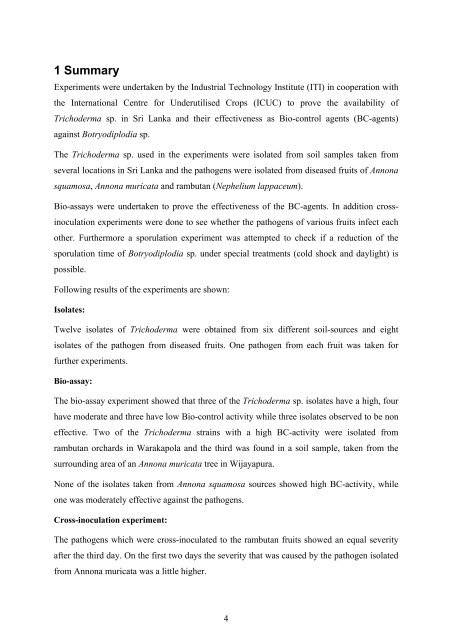Botryodiplodia sp. - Crops for the Future
Botryodiplodia sp. - Crops for the Future
Botryodiplodia sp. - Crops for the Future
Create successful ePaper yourself
Turn your PDF publications into a flip-book with our unique Google optimized e-Paper software.
1 Summary<br />
Experiments were undertaken by <strong>the</strong> Industrial Technology Institute (ITI) in cooperation with<br />
<strong>the</strong> International Centre <strong>for</strong> Underutilised <strong>Crops</strong> (ICUC) to prove <strong>the</strong> availability of<br />
Trichoderma <strong>sp</strong>. in Sri Lanka and <strong>the</strong>ir effectiveness as Bio-control agents (BC-agents)<br />
against <strong>Botryodiplodia</strong> <strong>sp</strong>.<br />
The Trichoderma <strong>sp</strong>. used in <strong>the</strong> experiments were isolated from soil samples taken from<br />
several locations in Sri Lanka and <strong>the</strong> pathogens were isolated from diseased fruits of Annona<br />
squamosa, Annona muricata and rambutan (Nephelium lappaceum).<br />
Bio-assays were undertaken to prove <strong>the</strong> effectiveness of <strong>the</strong> BC-agents. In addition crossinoculation<br />
experiments were done to see whe<strong>the</strong>r <strong>the</strong> pathogens of various fruits infect each<br />
o<strong>the</strong>r. Fur<strong>the</strong>rmore a <strong>sp</strong>orulation experiment was attempted to check if a reduction of <strong>the</strong><br />
<strong>sp</strong>orulation time of <strong>Botryodiplodia</strong> <strong>sp</strong>. under <strong>sp</strong>ecial treatments (cold shock and daylight) is<br />
possible.<br />
Following results of <strong>the</strong> experiments are shown:<br />
Isolates:<br />
Twelve isolates of Trichoderma were obtained from six different soil-sources and eight<br />
isolates of <strong>the</strong> pathogen from diseased fruits. One pathogen from each fruit was taken <strong>for</strong><br />
fur<strong>the</strong>r experiments.<br />
Bio-assay:<br />
The bio-assay experiment showed that three of <strong>the</strong> Trichoderma <strong>sp</strong>. isolates have a high, four<br />
have moderate and three have low Bio-control activity while three isolates observed to be non<br />
effective. Two of <strong>the</strong> Trichoderma strains with a high BC-activity were isolated from<br />
rambutan orchards in Warakapola and <strong>the</strong> third was found in a soil sample, taken from <strong>the</strong><br />
surrounding area of an Annona muricata tree in Wijayapura.<br />
None of <strong>the</strong> isolates taken from Annona squamosa sources showed high BC-activity, while<br />
one was moderately effective against <strong>the</strong> pathogens.<br />
Cross-inoculation experiment:<br />
The pathogens which were cross-inoculated to <strong>the</strong> rambutan fruits showed an equal severity<br />
after <strong>the</strong> third day. On <strong>the</strong> first two days <strong>the</strong> severity that was caused by <strong>the</strong> pathogen isolated<br />
from Annona muricata was a little higher.<br />
4

















